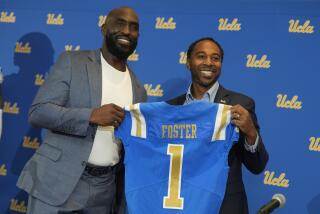The game’s changed for Pauley Pavilion
- Share via
The state of California, the University of California system and UCLA are making difficult decisions to prioritize their needs in line with available funds in these tough economic times. Such fiscal discipline should extend to the renovation of Pauley Pavilion.
In 2006, times were good: UCLA men’s basketball was back in the national spotlight after reaching the Final Four for the first time in more than a decade; the university was a fundraising juggernaut, having recently completed a $3-billion capital campaign; and the national and state economies were booming. Plans to improve Pauley Pavilion finally moved forward with exciting design concepts.
The university established a $100-million renovation budget and expected to fund nearly the entire project with major gifts, including a lead gift of at least $30 million. At the time, taking on significant debt and the use of student fees were not envisioned or even considered as viable financing sources.
However, times have changed. The economy is in the midst of a protracted downturn that has adversely affected UCLA and its faculty and students. The state budget agreement has reduced funding to state universities by nearly $3 billion, and the UC regents have approved tuition increases, faculty salary cuts and work furloughs.
UCLA Chancellor Gene Block has acknowledged the severity of UC’s problems, recently stating that “the financial crisis in California will, most likely, be long-lasting and require fundamental restructuring in the way UCLA operates.”
The economic downturn has also hurt the broader Bruin community, and after three years of active fundraising for the Pauley project, the results have not met expectations. The “Campaign of Champions” for the project has not produced a lead gift of $30 million. Media reports cite UCLA officials saying that the school has $53 million in donations and pledges. But UCLA’s July 14 report to the regents shows only $17 million in cash and signed pledges. The remaining funds are oral pledges “to be confirmed.”
So how is UCLA responding to the long-term challenges that the chancellor described? Well, first, it abandoned the design plans developed early in the process in favor of a set of designs that (a) UCLA now estimates will cost $185 million and (b) fails to solve many of the arena’s problems.
The school also intends to use $25 million in student fees for the project. The majority of those fees could and should be used to improve student programs and activities to help those hardest hit by the budget cuts. UCLA also plans to take on at least $60 million in debt, and because of the complexity of the project and UCLA’s construction track record, additional campus funds will be needed in the likely event that the project goes over budget.
To compensate for the significant fundraising shortfall, UCLA is targeting season ticket holders with a seating plan that is costly and inequitable. UCLA will now require longtime supporters to make one-time campaign gifts and to pay steep annual donations, in addition to the cost of season tickets.
Based on UCLA’s fundraising materials, more than 3,000 seats between the baskets and in the arena’s lower level will require such significant donations -- a $30,000 one-time payment and annual Wooden Fund donations of $2,000 to $4,000 per seat -- that the total cost of four tickets will go as high as $27,000 in the first season. In addition, UCLA is reserving the right to increase required annual donations one year after the arena reopens. On a per-game basis, those UCLA men’s basketball tickets will cost more than comparable tickets for the Los Angeles Lakers, who have the NBA’s highest average ticket price.
Not only is the cost of the seating plan excessive, UCLA is requiring donors to make these blind pledges (a minimum of $30,000 for the seats between the baskets) well in advance of determining priority rankings for seat selection. Rankings are not expected to be finalized until 2011. Fans have the right to know where they are going to sit before making an irrevocable financial commitment. Moreover, UCLA’s point system prioritizes new donations at the expense of loyal season ticket holders. A new donor only has to make a pledge of $8,400 by Dec. 31 to leapfrog a 20-year season ticket holder in the seat-selection process.
The renovation’s original objectives included constructing modern athletic facilities and improving the arena’s safety features (handrails, steps, etc.), sight lines, traffic flow, restrooms and concessions. UCLA should prioritize these goals and proceed with a project that does not exceed funds raised from major gifts. This approach would distribute the potentially long-lasting budget crisis more equitably throughout the campus, maximize the university’s educational impact, enable its diverse alumni base to attend events at Pauley Pavilion and once again allow UCLA athletics to lead by example.
More to Read
Sign up for Essential California
The most important California stories and recommendations in your inbox every morning.
You may occasionally receive promotional content from the Los Angeles Times.













